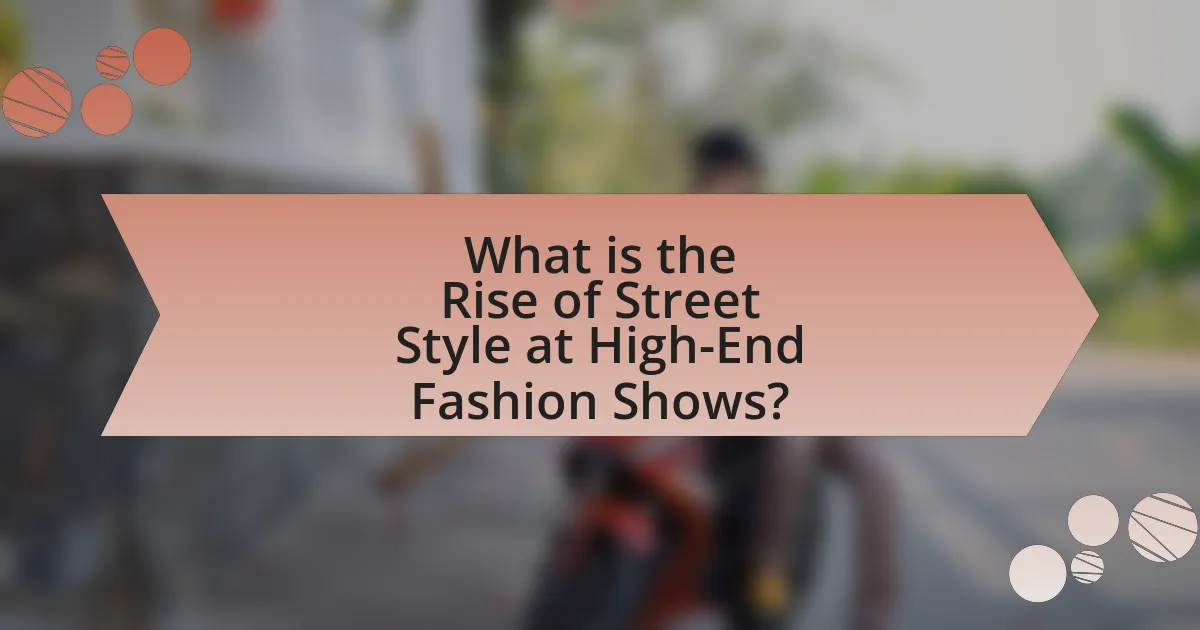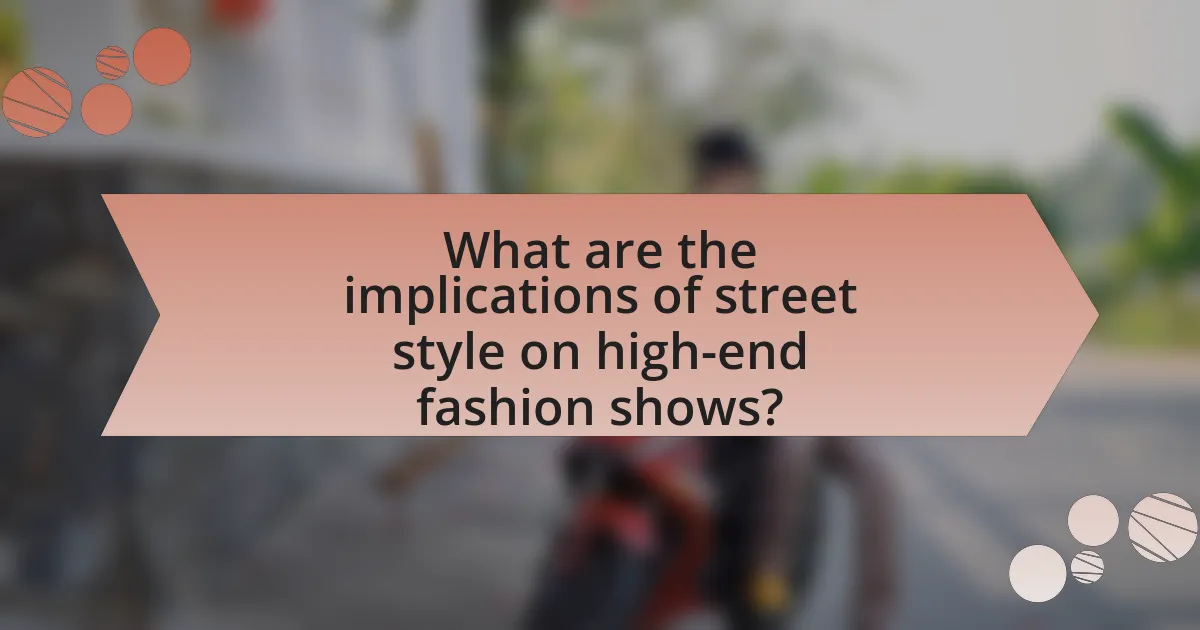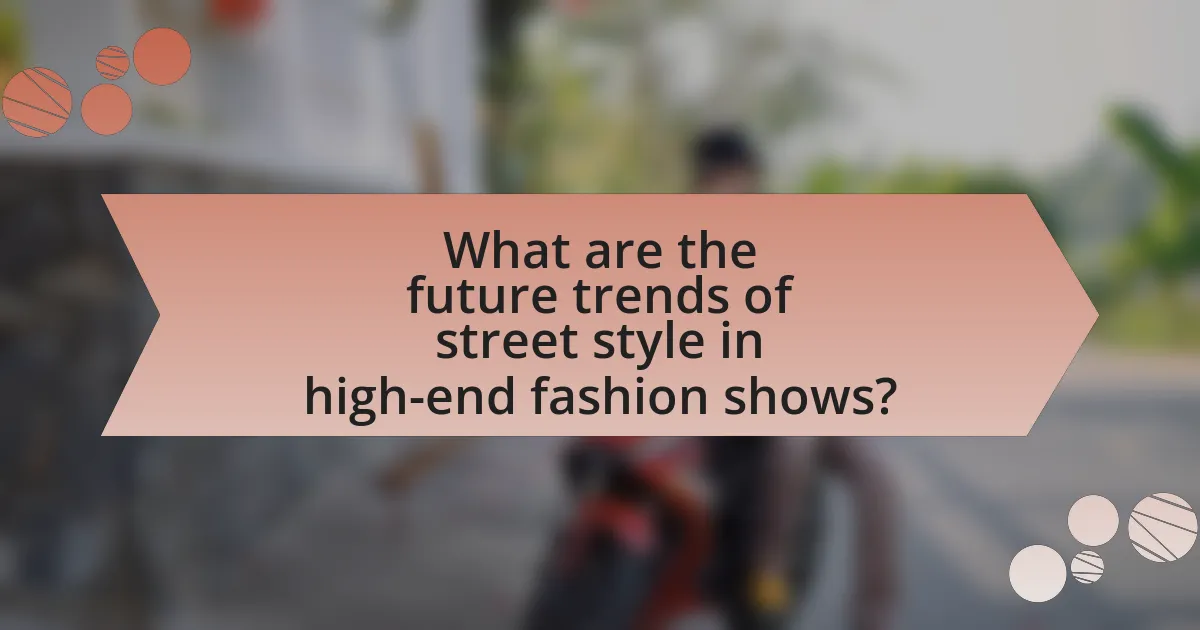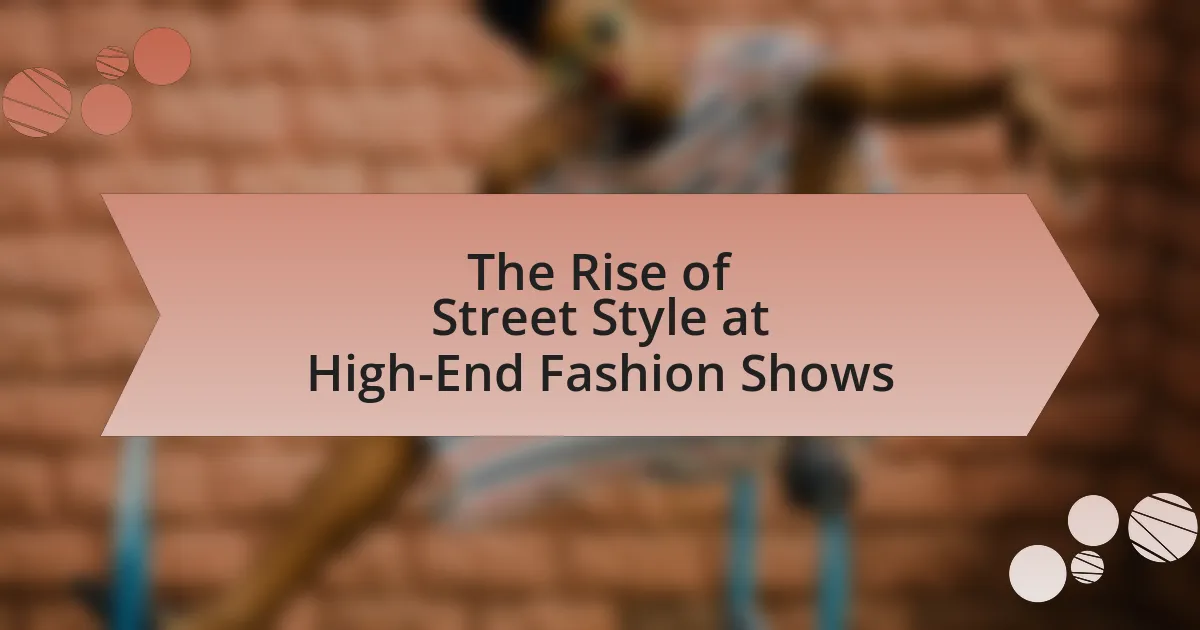The article examines the rise of street style at high-end fashion shows, highlighting its influence on luxury runway presentations. It discusses how designers are increasingly incorporating casual, urban fashion elements into their collections, reflecting a shift towards inclusivity and accessibility. Key characteristics of street style, such as individuality and the blend of high and low fashion, are explored, along with the role of social media and influencers in shaping trends. The article also addresses the implications of this trend for traditional fashion norms, the response of established fashion houses, and future directions for street style in the fashion industry.

What is the Rise of Street Style at High-End Fashion Shows?
The rise of street style at high-end fashion shows refers to the increasing influence of casual, urban fashion on luxury runway presentations. This trend has transformed traditional fashion shows, where designers now incorporate elements of streetwear, reflecting a shift towards inclusivity and accessibility in fashion. Notably, events like New York Fashion Week have seen models wearing sneakers and oversized silhouettes, showcasing a blend of high fashion with everyday wear. This evolution is supported by the growing prominence of social media, where street style is widely shared and celebrated, further blurring the lines between high fashion and streetwear.
How has street style influenced high-end fashion shows?
Street style has significantly influenced high-end fashion shows by integrating casual, everyday aesthetics into luxury collections. This shift is evident in the adoption of relaxed silhouettes, bold patterns, and eclectic layering, which reflect the diverse and individualistic nature of street fashion. Designers such as Balenciaga and Gucci have incorporated elements like oversized fits and graphic tees, showcasing how street style can redefine luxury. The impact is further validated by the rise of social media platforms, where street style is widely shared and celebrated, prompting high-end brands to respond to consumer preferences for authenticity and relatability in fashion.
What are the key characteristics of street style in this context?
Key characteristics of street style in the context of high-end fashion shows include individuality, casual aesthetics, and a blend of high and low fashion. Individuality is emphasized as street style allows personal expression, showcasing unique combinations of clothing that reflect the wearer’s personality. Casual aesthetics are prevalent, as street style often incorporates relaxed, comfortable pieces that contrast with traditional formal wear seen on runways. The blend of high and low fashion is significant, as street style frequently merges luxury items with affordable pieces, creating a diverse and accessible fashion narrative. This evolution has been documented in various fashion studies, highlighting how street style influences mainstream fashion trends and consumer behavior.
How does street style differ from traditional high-end fashion?
Street style differs from traditional high-end fashion primarily in its accessibility and emphasis on individuality. While traditional high-end fashion often showcases exclusive designs from luxury brands that cater to a wealthy clientele, street style reflects everyday wear influenced by urban culture and personal expression. Street style is characterized by its democratic nature, allowing anyone to participate and express their unique identity through fashion, whereas traditional high-end fashion typically involves a more formalized and elitist approach, often showcased in runway shows and high-profile events. This distinction highlights the contrast between the curated, often unattainable aesthetics of luxury fashion and the relatable, diverse expressions found in street style.
Why is street style gaining popularity in high-end fashion shows?
Street style is gaining popularity in high-end fashion shows because it reflects a more authentic and relatable approach to fashion, appealing to a broader audience. This shift is driven by the influence of social media, where everyday fashion is celebrated and shared, allowing designers to connect with consumers on a personal level. Additionally, high-end brands are increasingly incorporating streetwear elements into their collections, recognizing the demand for casual yet stylish attire. The blending of luxury and street style has been validated by collaborations between high-fashion houses and streetwear brands, such as the partnership between Louis Vuitton and Off-White, which showcases the growing acceptance of street style in prestigious fashion contexts.
What cultural shifts have contributed to this trend?
The cultural shifts contributing to the rise of street style at high-end fashion shows include the democratization of fashion, the influence of social media, and a growing emphasis on individuality and self-expression. The democratization of fashion has blurred the lines between high fashion and everyday wear, allowing street style to gain recognition as a legitimate form of fashion. Social media platforms, particularly Instagram, have enabled influencers and everyday individuals to showcase their personal styles, leading to a broader acceptance of diverse fashion expressions. Additionally, the cultural movement towards valuing authenticity and personal narratives has encouraged designers and brands to incorporate street style elements into their collections, reflecting a shift away from traditional fashion hierarchies.
How do social media and influencers play a role in this rise?
Social media and influencers significantly contribute to the rise of street style at high-end fashion shows by amplifying visibility and shaping trends. Platforms like Instagram and TikTok allow influencers to showcase their personal styles, which often blend high fashion with everyday wear, thereby democratizing fashion and making it more accessible. According to a 2021 study by the Fashion Institute of Technology, 70% of consumers reported being influenced by social media when making fashion purchases, highlighting the direct impact of these platforms on consumer behavior. Influencers, with their large followings, create a sense of aspiration and relatability, encouraging fans to adopt street style elements into their wardrobes, further blurring the lines between luxury fashion and everyday attire.

What are the implications of street style on high-end fashion shows?
Street style significantly influences high-end fashion shows by democratizing fashion and shifting design aesthetics towards more relatable and wearable pieces. This trend has led luxury brands to incorporate elements of casual wear, resulting in collections that resonate with a broader audience. For instance, designers like Balenciaga and Gucci have embraced streetwear influences, reflecting a cultural shift where high fashion increasingly draws inspiration from everyday attire. This integration not only enhances brand accessibility but also drives sales, as evidenced by the rise in popularity of athleisure and casual luxury, which accounted for a substantial portion of the fashion market growth in recent years.
How does street style affect designer collections and presentations?
Street style significantly influences designer collections and presentations by serving as a source of inspiration and a reflection of contemporary culture. Designers often observe street fashion trends to gauge consumer preferences, leading to the incorporation of casual, urban elements into their collections. For instance, the rise of athleisure in high fashion can be traced back to street style, where comfort and functionality became paramount. This shift is evident in collections from brands like Balenciaga and Off-White, which blend high fashion with everyday wear, showcasing how street style shapes runway aesthetics. Additionally, street style impacts the presentation format, as designers increasingly adopt informal settings and diverse models to resonate with a broader audience, reflecting the democratization of fashion.
What changes have designers made in response to street style?
Designers have increasingly incorporated casual and eclectic elements into their collections in response to street style. This shift includes the use of oversized silhouettes, bold graphics, and a mix of textures that reflect urban aesthetics. For instance, luxury brands like Balenciaga and Off-White have embraced streetwear influences, showcasing items such as hoodies, sneakers, and distressed denim on high-fashion runways. This trend has been validated by the growing popularity of street style icons and the integration of streetwear into luxury fashion, as evidenced by collaborations between high-end designers and streetwear labels, which have become a significant part of contemporary fashion culture.
How do fashion critics perceive the integration of street style?
Fashion critics generally perceive the integration of street style as a transformative influence on high-end fashion, recognizing it as a bridge between luxury and everyday wear. This perspective is supported by the increasing presence of streetwear aesthetics in major fashion shows, where designers incorporate casual elements into their collections, reflecting a shift towards inclusivity and relatability in fashion. Critics note that this trend democratizes fashion, making it more accessible and resonant with a broader audience, as evidenced by the rise of brands like Off-White and Supreme, which have successfully merged street style with high fashion.
What challenges does the rise of street style present to traditional fashion norms?
The rise of street style presents significant challenges to traditional fashion norms by democratizing fashion and blurring the lines between high fashion and everyday wear. This shift disrupts established hierarchies, as street style emphasizes individual expression over designer authority, leading to a more inclusive fashion landscape. For instance, the increasing visibility of streetwear brands at prestigious fashion events, such as New York Fashion Week, showcases how casual attire can gain equal footing with haute couture, challenging the notion that luxury fashion must adhere to formal standards. Additionally, the rapid dissemination of street style through social media platforms accelerates trends, making traditional seasonal collections less relevant and forcing established brands to adapt quickly to consumer preferences.
How do established fashion houses respond to the street style movement?
Established fashion houses increasingly embrace the street style movement by incorporating urban aesthetics into their collections and marketing strategies. This shift is evident in collaborations with streetwear brands, such as Louis Vuitton’s partnership with Off-White, which merges luxury with street culture. Additionally, fashion houses are showcasing street style influences on runways, as seen in Balenciaga’s designs that reflect everyday wear, thus appealing to a broader audience. The integration of street style elements allows these brands to remain relevant and connect with younger consumers who prioritize authenticity and individuality in fashion.
What are the potential risks for brands embracing street style?
Brands embracing street style face several potential risks, including brand dilution, misalignment with target demographics, and backlash from traditional consumers. Brand dilution occurs when high-end brands adopt street style, potentially undermining their luxury status and exclusivity. Misalignment with target demographics can lead to alienation of core customers who may not resonate with the casual aesthetic, resulting in decreased sales. Additionally, backlash from traditional consumers can manifest as negative public perception, particularly if the street style is perceived as inauthentic or overly commercialized. These risks highlight the need for brands to carefully navigate the integration of street style into their identity while maintaining their core values and customer loyalty.

What are the future trends of street style in high-end fashion shows?
Future trends of street style in high-end fashion shows will increasingly emphasize personalization and inclusivity. Designers are shifting towards collections that reflect diverse cultural influences and individual expression, moving away from traditional runway aesthetics. This trend is supported by the rise of social media platforms, where influencers and everyday fashion enthusiasts showcase their unique styles, prompting high-end brands to adapt. For instance, brands like Balenciaga and Off-White have successfully integrated streetwear elements into their collections, demonstrating a blend of luxury and casual wear that resonates with a broader audience.
How might street style evolve in upcoming fashion seasons?
Street style is likely to evolve in upcoming fashion seasons by increasingly integrating sustainable practices and technology-driven designs. As consumer awareness of environmental issues rises, designers are expected to incorporate eco-friendly materials and ethical production methods into streetwear, reflecting a broader trend towards sustainability in fashion. Additionally, the influence of digital platforms and social media will continue to shape street style, with virtual fashion shows and augmented reality experiences becoming more prevalent, allowing for innovative expressions of personal style. This evolution is supported by the growing popularity of brands that prioritize sustainability, such as Stella McCartney and Patagonia, which have successfully merged street style aesthetics with eco-conscious practices.
What emerging designers are leading the street style movement?
Emerging designers leading the street style movement include brands like Ader Error, Marine Serre, and Telfar. Ader Error is known for its playful deconstruction and unique graphics, which resonate with urban youth culture. Marine Serre has gained attention for her innovative use of upcycled materials and distinctive crescent moon motifs, appealing to eco-conscious consumers. Telfar, recognized for its unisex designs and inclusive branding, has become a staple in streetwear, particularly with its popular shopping bags. These designers are shaping contemporary street style by blending high fashion with everyday wear, reflecting the cultural shifts in fashion consumption.
How will technology influence the future of street style at fashion shows?
Technology will significantly influence the future of street style at fashion shows by enabling real-time social media sharing and augmented reality experiences. The integration of platforms like Instagram and TikTok allows attendees to instantly showcase their outfits, creating a dynamic feedback loop that shapes trends. Additionally, augmented reality applications can enhance the viewing experience, allowing users to visualize how street style pieces would look on them before purchasing. This shift is supported by data indicating that 54% of consumers prefer to see how clothing looks on real people rather than models, emphasizing the importance of relatable street style in high-end fashion contexts.
What practical tips can fashion enthusiasts take from the rise of street style?
Fashion enthusiasts can adopt a more personalized and experimental approach to their wardrobe by embracing the principles of street style. This trend emphasizes individuality, encouraging people to mix high and low fashion, layer clothing creatively, and incorporate unique accessories. For instance, street style has shown that pairing designer pieces with thrifted items can create a distinctive look that stands out. Additionally, the rise of street style highlights the importance of comfort and practicality, as many street style icons prioritize wearable outfits that reflect their personal style rather than strictly adhering to traditional fashion norms. This shift is supported by the fact that street style has increasingly influenced high-end fashion, with designers often drawing inspiration from the authentic looks seen on the streets.
How can individuals incorporate street style into their personal fashion?
Individuals can incorporate street style into their personal fashion by blending casual, urban-inspired pieces with their existing wardrobe. This can be achieved by selecting key elements such as oversized jackets, graphic tees, distressed jeans, and statement sneakers, which are hallmarks of street style. Research indicates that street style has significantly influenced high-end fashion, with designers often drawing inspiration from urban aesthetics seen on the streets. For example, the integration of streetwear brands into luxury collections has become prevalent, showcasing the acceptance and popularity of this style. By mixing these elements with personal favorites, individuals can create unique outfits that reflect their personality while embracing the street style trend.
What are the best practices for attending high-end fashion shows with a street style approach?
To effectively attend high-end fashion shows with a street style approach, individuals should prioritize unique personal expression through their outfits while ensuring comfort and practicality. This means selecting bold, statement pieces that reflect current trends but also resonate with one’s personal aesthetic, as seen in the rise of influencers who blend high fashion with everyday wear. Additionally, it is essential to consider the venue and weather conditions, opting for layers that can be adjusted as needed, which is a common practice among seasoned attendees. Engaging with the fashion community through social media before and after the event can enhance visibility and networking opportunities, as many attendees share their experiences online, contributing to the street style narrative.
